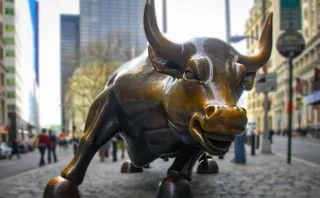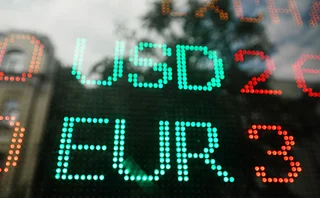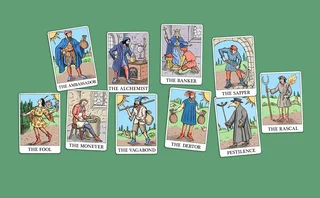
In bank runs and market crashes, it matters how ideas ‘catch’
Contagion episodes show importance of network effects in finance
The Twitter-fuelled run on Silicon Valley Bank and its fallout in markets has sparked renewed interest in how financial contagion spreads through webs of connections, causing fortunes to sometimes turn on a dime.
“There were a couple of Tweets and then this thing went down much faster than has happened in history,” Citigroup chief executive Jane Fraser said in a Bloomberg interview in March. “It’s a complete game-changer from what we’ve seen before.”
Contagion through new social media channels and old-fashioned word of mouth may also explain why the first casualty of a California bank run was a respectably capitalised firm nearly 6,000 miles away, albeit a troubled one in other respects.
The power of viral narratives cascading through networks of contacts, as witnessed in recent months, raises new questions, too. How far do outcomes depend on the composition and topology of the network — that’s to say, the balance of different actors in the system and who influences whom?
It’s a question academics have been thinking about since the late 1990s when research pointed to how releasing information to certain combinations of informed and impressionable actors can produce chaotic results.
“If the world were made up of Warren Buffetts, bubbles and crashes wouldn’t happen,” says Tim Hellmann, an associate professor in economics at the UK’s University of Southampton. A certain balance of Buffetts and other types of investors, though, might create the bumpier conditions investors would recognise.
Hellman is investigating how the make-up of markets — putting all other factors aside — might play a role in booms and busts. By studying different networks of rational agents in a computer model, he and his colleagues have been able to show that how the agents are linked can explain a lot. Network effects on their own are capable of creating bubbles and cycles, for example.
Through analysis of every possible configuration of linkages it emerges that different set-ups lead to different market patterns — some healthy and calm, others more feverish. The effects come down to the network centrality of certain agents, something that can be quantified with metrics like those employed at Google to rate web pages based on their number of links.
Hellmann’s model mimics a financial market, but the logic could apply to other pieces of the ecosystem such as banking deposits.
One type of network in particular leads to markets where prices bubble and crash, Hellmann says. These are networks in which a few “closed” groups of highly influential agents — the Warren Buffetts or Peter Thiels of the world — mix with a broader mass of more impressionable actors. Closed means the influencers are stubborn in their views, largely ignoring what others think. For market participants, it’s a familiar description.
What does the power of network effects mean in practice? For one, it’s an idea that could help shape policy. Hellmann is talking to the European Investment Bank, the Bank of England and the OECD about collaborating on a project to look at the spread of green investing, for example. If the popularity of green investing hinges on the views of a few key influencers, policy-makers might consider measures to nudge such influencers in a preferred direction.
Similar thinking could also be coming to bank regulation. The Financial Stability Board is examining the role social media played in the bank runs that brought down Credit Suisse, SVB and others.
In the meantime, a growing understanding of networks suggests regulators and risk managers should be tracking how ideas spread in networks and on social media, as well as what those ideas are and who is pushing them.
Only users who have a paid subscription or are part of a corporate subscription are able to print or copy content.
To access these options, along with all other subscription benefits, please contact info@risk.net or view our subscription options here: http://subscriptions.risk.net/subscribe
You are currently unable to print this content. Please contact info@risk.net to find out more.
You are currently unable to copy this content. Please contact info@risk.net to find out more.
Copyright Infopro Digital Limited. All rights reserved.
As outlined in our terms and conditions, https://www.infopro-digital.com/terms-and-conditions/subscriptions/ (point 2.4), printing is limited to a single copy.
If you would like to purchase additional rights please email info@risk.net
Copyright Infopro Digital Limited. All rights reserved.
You may share this content using our article tools. As outlined in our terms and conditions, https://www.infopro-digital.com/terms-and-conditions/subscriptions/ (clause 2.4), an Authorised User may only make one copy of the materials for their own personal use. You must also comply with the restrictions in clause 2.5.
If you would like to purchase additional rights please email info@risk.net
More on Investing
Sticky fears about sticky inflation
Risk.net survey finds investors are not yet ready to declare victory on inflation – with good reason
S&P bull run drives interest in reset and lookback hedges
Variable strike put options proved popular alternative hedging format of 2025
US mutual funds slash short euro positions at record pace
Counterparty Radar: Pimco cut $4.6bn of EUR/USD puts in Q3 amid changing stance on dollar direction
How investment firms are innovating with quantum technology
Banks and asset managers should be proactive in adopting quantum-safe strategies
Top 10 investment risks for 2026
AI, strained governments, inflated private assets: risky bets have become hard to avoid
Review of 2025: It’s the end of the world, and it feels fine
Markets proved resilient as Trump redefined US policies – but questions are piling up about 2026 and beyond
Asset managers prep autocall ETFs with assets tipped to hit $30bn
Actively managed strategies wait in the wings after systematic approach nets Calamos $500m
Citi launches core inflation QIS
Custom indexes eliminate energy and food prices to ease trading of stickier inflation trends








